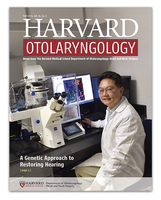
Formally established in the 1800s, we have a long history of medical breakthroughs within the field of otolaryngology (ear, nose, and throat care).
1888
Clarence John Blake, MD, is named the first Professor and Chairman of the Harvard Medical School Department of Otology.
The Board of Managers of the Massachusetts Charitable Eye and Ear Infirmary open a clinic for teaching otology to Harvard Medical School students.
John Orne Greene, MD, is named Professor of Clinical Otology at Harvard Medical School and becomes the first surgeon in the United States to perform the postauricular Wilde incision and the Schwartze simple mastoid procedure.
Frederick Irving Knight, MD, becomes the first Clinical Professor of Laryngology at Harvard Medical School.
1892
Frederick L. Jack, MD, becomes an Assistant Surgeon at the Massachusetts Charitable Eye and Ear Infirmary under Clarence John Blake, MD, and performed the first stapedectomy in the United States.
1900
Harvard Medical School’s otolaryngologic instruction finds a home at Massachusetts Eye and Ear, where it remains today.
1903
The Mosher Course, a famed Harvard Medical School postgraduate course in head and neck anatomy, is established and taught by Harris Peyton Mosher, MD.
1906
The Harvard Medical School/Massachusetts General Hospital Department of Laryngology is established under the direction of Algernon Coolidge, Jr., MD.
1907
Clarence John Blake, MD, becomes the first incumbent of the Walter Augustus Lecompte Chair at Harvard Medical School.
1918
Eugene Crockett, MD, is named the second Walter Augustus Lecompte Professor of Otology at Harvard Medical School.
1923
Varaztad H. Kazanjian, MD, DMD, becomes the first Chief of the Plastic Surgery Service at Mass Eye and Ear and Harvard Medical School’s first Professor of Plastic Surgery.
1924
Harold Walker, MD, is named the third Walter Augustus Lecompte Professor of Otology at Harvard Medical School.
1932
Harris Peyton Mosher, MD, becomes the first Chief of Otology and Laryngology at Harvard Medical School.
1939
LeRoy A. Schall, MD, becomes Chief and Chair of Otology and Laryngology at Harvard Medical School.
1958
The Eaton-Peabody Laboratory of Auditory Physiology is established as a multidisciplinary laboratory, including Massachusetts Institute of Technology, Harvard University, Massachusetts General Hospital, and Mass Eye and Ear. The lab is currently the largest hearing research facility in the world.
1961
Harold F. Schuknecht, MD, becomes Chief and Chair of Otology and Laryngology at Harvard Medical School.
1985
Joseph B. Nadol, Jr., MD, is named the fifth Chief of Otolaryngology at Mass Eye and Ear and the Walter Augustus LeCompte Professor and Chair of Otology and Laryngology at Harvard Medical School.
1993
A surgical method to restore speech, swallowing, and normal breathing in patients with paralyzed vocal cords is developed.
2003
Stem cells in the inner ear that were converted into mature hair cells, which may someday lead to ways of restoring lost hearing, are discovered.
2014
D. Bradley Welling, MD, PhD, FACS, is named as the sixth Chief of Otolaryngology for the Mass Eye and Ear/Massachusetts General Hospital departments and Chairman of Otolaryngology for Harvard Medical School.
2019
Department name changed to Harvard Medical School Department of Otolaryngology–Head and Neck Surgery.
2021
Mark A. Varvares, MD, FACS, is named the seventh Chief of Otolaryngology–Head and Neck Surgery for the Mass Eye and Ear/Massachusetts General Hospital departments and Chair of Otolaryngology–Head and Neck Surgery at Harvard Medical School.

